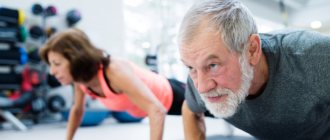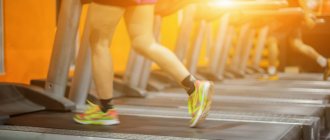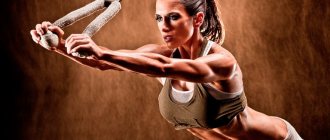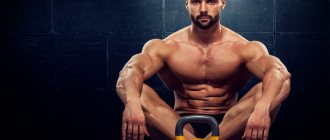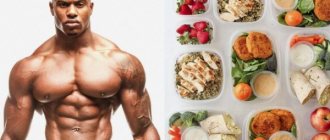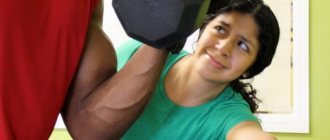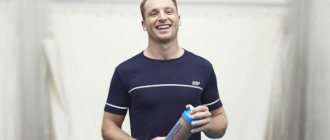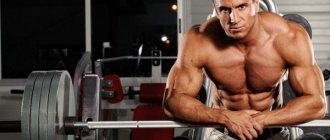August 7, 2021 Admin Home page » Tips and tricks
Find out tips for increasing arm volume; we have collected only time-tested recommendations, evaluated by experts and stars of fitness and bodybuilding.
The T-shirt hangs loosely on your arm, the volume of your biceps is 35 cm, and you think that having good definition is enough. Then this article is definitely not for you, but for those who want to have an arm volume of at least 42-45 cm, then you have hit the nail on the head. Read and find out 8 important tips when arm muscle training is almost 100% effective.
Arm training for mass: how to pump up big arms
An increase in the volume of the triceps and biceps muscles is carried out as part of arm weight training, which consists of the simultaneous development of antagonists responsible for flexion and extension of the upper limbs. Alternately performing exercises to develop triceps and biceps contributes to their accelerated recovery. The flow of oxygen-enriched blood increases, and this has a beneficial effect on weight growth.
Anatomy of human hands
You can properly organize the training process if you know the anatomy of the upper extremities. The biceps consists of a long, short head, abdomen and radial process. The triceps is a triceps muscle with a fusiform appearance, consisting of 3 heads: long, lateral, medial. In addition, there are several thin muscles of the forearm:
- brachialis;
- brachyradialis;
- coracobrachial;
- extensor carpi radialis longus.
When thinking about how to pump up big arms, bodybuilders strive to select exercises and choose their optimal combination, determining the appropriate load taking into account the number of repetitions, approaches, and working weight to ensure progression, which serves as the key to increasing mass.
Anatomy of arm muscles
The arms consist of the biceps, triceps and radialis, as well as the forearms, but that’s another topic; we’ll talk about grip strength in another article, so subscribe to updates so you don’t miss anything. So, from a training point of view, it is better to divide the arm into flexors and extensors. The extensor arm is a triceps, it consists of three heads that differ in their length and, accordingly, strength. The strongest head of the triceps is the medial one, the weakest is the inner one, so the emphasis should always be on the inner part of the triceps, since two muscles are always stronger than one! The flexors of the arm are the biceps and radialis muscles. The biceps consists of two bundles: internal and lateral, the internal one is larger, and the lateral one is smaller, but it is necessary to train both of them, and it is better to do this with different exercises, that is, one to emphasize pumping the inner head of the biceps, and the other the outer one. The radialis muscle works during any bending of the arms, but is more involved when your hand is pronated, that is, turned with your palms facing the floor, or when it is in a neutral position.
To accumulate the load in the triceps, you must exclude the shoulder joint from the work and shift all the work to the elbow. When you perform presses with a narrow grip, the amplitude of movement from the top of the abs upward is carried out only due to the extension of the elbow joint; when you perform a French press, your shoulders are in a fixed position. In order to load the internal triceps bundle, it is necessary to bring your elbows together, because if you move them apart, the load will go into the lateral and medial bundles, as well as into the pectoral muscles. It is best to train the triceps in a large enough repetition range so that each set takes you from 30 to 50 seconds, so the optimal number would be 10-15 repetitions.
When training biceps, the position of your elbow depends on which biceps you are training. If you are training the internal beam, then your elbows should be brought forward, pressing your hands against the pectoralis major muscle so that your elbows are against the front of the obliques. If it is necessary to load the lateral bundle, then the elbows, on the contrary, must be pulled back so that a gap is formed between the bend of the elbow and the latissimus muscle. You should extend your arms completely, stretching the biceps as much as possible, but bend them to the point at which peak contraction occurs, since then the load shifts from the biceps to the elbow joint. In addition, in your arm training, you should also take into account the fact that the biceps also performs the function of turning the hand, so the arm must not only be bent, but also supinated.
It is not necessary to supinate the hand in all exercises, especially since this is only possible when you train your arms with dumbbells, but such exercises should also be used. The principle you already know works here - two are always more than one! Since the biceps performs two functions, then by training them both, you will achieve more than by training only one. Moreover, the flexion function is mainly performed by the radialis muscle, therefore, if weights are not working for you, then you should include hammers and reverse curls with a barbell in your training, rather than trying to “hammer” the biceps with concentrated curls. However, such special isolating exercises also need to be included in the training split, there’s just a place and time for everything.
Causes of hand lag
Well, let’s say the athlete knows and practices the basics of arm training, but why do the arms still lag behind? This, of course, has to do with genetics! The same muscle group can vary greatly in structure among different athletes. Some people have long biceps, others have short ones, and the same applies to triceps. Accordingly, if the muscle is short, then the tendon is long, so it is more difficult to use the muscle, and if it is more difficult, then the body tries to do the work at the expense of other muscles, since it is easier to do so. Hence the conclusion: if you have short biceps, then you need to isolate it very well. The same rule works with long triceps. True, in return for great effort when training the triceps, the athlete will get a more beautiful muscle, but short biceps will not look very good in any case.
Muscle composition is the second factor . Muscle fibers are divided according to the criteria of ATPase myofibrils and the number of mitochondria. Accordingly, one athlete may have more slow muscle fibers, another more fast ones, so pumping is more suitable for one, and more powerful types of load for the other. Conclusion: you need to individually select the basic training methodology for yourself in order to decide what works best. Therefore, it is necessary to keep a training diary , looking into which you can track your progress. There is another option to cut off a piece of muscle and submit it for laboratory analysis, no, I don’t like it, well, then only with the help of a diary.
The third factor is a whole complex of various errors that are not associated with genetics or any individual characteristics of the athlete. Such mistakes include an incorrectly structured training split and the training itself. Hand training must be adequate, correct, and suitable for the athlete. Such training should stimulate protein synthesis and allow progress. If an athlete overloads a muscle, then it naturally does not grow; if he does not train it, then it naturally does not grow. Conclusion: it is necessary to follow the fundamental principles of bodybuilding, which we wrote about above.
The biceps and triceps must be adequately loaded and given enough resources to recover, after which, in the supercompensation phase, they can be trained again.
Basic exercises for triceps
When thinking about how to build muscle mass in your arms, you need to consider that 2/3 of the volume is formed by the triceps . Therefore, more attention in training should be paid to the triceps brachii muscle by performing the following exercises.
Close-grip barbell bench press
- You need to position yourself so that your buttocks and shoulder blades with the back of your head are pressed tightly against the surface, and the bar is directly above your forehead.
- Spread your legs as wide as possible to give your torso a stable position.
- The projectile is pulled up, with the bar positioned above the chest and, while inhaling, lowered to the sternum, while the elbows are pressed to the body.
- After touching the body, the bar is pushed up until the arms are straightened.
French press
French press, performed in a lying position on a horizontal bench.
- Extend your straightened arms upward, placing them perpendicular to the floor surface.
- Take the projectile with an overhand grip, align your arms and move them back 40° from the vertical.
- After inhaling and holding your breath, lower the bar to the back of your head, bending your elbows, while keeping your upper arms in a fixed position.
- The angle at the elbows below is 90°.
- Having brought the barbell to the extreme point at the bottom, straighten your arms and return it to the starting position.
Extensions from the upper block
- Extend your arms downwards until they touch your hips, holding for maximum load.
- Slowly bend your arms back to their original position, applying a certain amount of force.
- Inhalation is performed in the first phase of the exercise with the elbows fixed in one position.
Basic exercises for biceps
While focusing on how to build muscle in your arms, don't forget about your biceps by doing basic exercises for your biceps brachii.
Lifting the bar
"Hammers"
- Hold the dumbbells with a simple grip, bending slightly at the lower back.
- Lower your hands to your hips, inhaling and holding your breath to then lift the dumbbell to the delta.
- Keep your elbows close to your body and do not move them while performing the exercise.
- The hand lingers at the chest for a couple of seconds, after which an exhalation is made and it lowers into the IP.
Alternating dumbbell raises in a seated position
- Sit comfortably on a bench and lower your arms straight down.
- The torso remains straight to avoid rounding of the spine.
- Raise the dumbbells to your shoulder and lower them down without pausing.
Training program
All that remains is to correctly combine the selected exercises, developing an effective program aimed at increasing the mass and volume of the arms. Do everything in the following sequence, observing the dosage:
- lifting the barbell in a standing position;
- bench press;
- "hammers";
- then proceed to perform the French press;
- and then do dumbbell biceps curls and triceps extensions, alternating these two exercises with a superset.
You need to perform 8–10 repetitions, doing at least 3 series.
Hand training with specialization
First of all, you should abandon the idea of “I want everything at once,” since in order to specialize in the arms you will have to sacrifice the intensity of training other muscle groups. Why? Because resources are limited! We do not recommend completely stopping training other muscle groups, but they should be trained optionally and with emphasis on the arms. In this case, you will train your arms twice a week, but observing the principle of periodization. One arm workout will be pumping, and the other will be more strength training. In other words, you will train fast muscle fibers in one workout, and slow muscle fibers in another. At the same time, the program itself must be constant so that you can progress. Today you did biceps curls with 40kg, a week later with 42kg, etc.
Biceps and triceps workout
It is most effective to set aside a separate day for training these muscle groups, and their training can also be combined with training the shoulder girdle. This is exactly what you will do! In one workout you will work your arms separately, and in another you will combine them with shoulder training. During the second workout, you will train your arms first, since the target muscle group should always be trained first. The same rule applies to what you will pump first - biceps or triceps. If you want to progress more in your biceps, then you should train it first. On the other hand, sometimes muscles should be swapped, since this will serve as an additional and, most importantly, unusual stress to which the body will have to adapt.
There are three ways to train your arms: supersets, alternating exercises, and alternating muscle groups. Supersets are the most effective method, where the athlete performs 1 set of biceps, a non-resting set of triceps, and then rests for a minute. Pros: muscles recover better, are better washed with blood, and during training both muscle groups the athlete has equal strength. The second method involves doing an exercise on one muscle group and then doing it on another. The advantage is that in this case the athlete can perform dropsets and complex sets. A drop set is a long approach with a gradual decrease in weight on the bar, and a complex set is two exercises for one muscle group in a row. Alternating muscle groups is such an organization of training when the athlete first performs all the exercises for one muscle group, and then moves on to training the second. The advantage is that you can spend more time on the target muscle, since the athlete has more strength at the beginning of the workout than at the end.
The secrets of training biceps and triceps, as well as how to include arm training in a training split and, in general, the training program itself, as well as professional systems for training arm muscles, see the next page.
Next page
Recommendations
Find out how to build big arms with the best advice from leading athletes who recommend avoiding common mistakes that slow down progress or lead to improper development:
- load progression is not applied: it is necessary to increase the intensity, number of repetitions, approaches;
- execution technique is broken;
- incorrect recovery;
- unbalanced diet.
Knowing how to pump up big arms, select exercises that have the maximum effect for increasing mass and volume.
How to build powerful muscle mass in your arms. Strategy and training plan.
This story happened in my first gym:
On topic: Shaking up your arms with Anna Kurkurina
-I need to train my biceps at every workout, so my arms will become more massive and quickly acquire athletic shape.
-Yes, you're right, your biceps will appear much faster, but why did you decide that your arms will become more massive?
-But so here it is (bends his hand)
-What on the other side?
-What about the other one, I don’t understand.
-And on the other hand, the triceps brachii muscle or triceps and it makes up 2/3 of the volume of the arm. Therefore, if you want to increase the mass of your arms, copy this training program for triceps into your training diary. I have collected several very effective exercises in it.
Triceps training plan:
1. Arm extensions on parallel bars. This heavy basic exercise will work not only the triceps, but also the pectorals and deltoids. The load can be emphasized on the triceps if you perform the exercise strictly vertically and shallowly. But I recommend performing it in the classical amplitude, especially if you have not yet had time to pump yourself up enough. Perform 3 heavy sets of 8-10 reps.
2.French bench press. Lower the weight as hard and slow as possible, giving the triceps a good stretch at the bottom. Perform 3 sets with a good weight of 12 reps.
3. Arm extensions in a block exercise machine with a rope handle. It is most effective to perform in full amplitude, fixing the peak contraction at the very bottom of the trajectory. Perform 3 “pump” approaches until burning, 15 repetitions each.
If you successfully select the working weights, then this program will definitely make your arms grow.
And here you can see a similar plan for biceps.
Source
When curling your arms, do not lift the barbell or dumbbells high
Very often, when the weight is quite significant, for example, when lifting a barbell for biceps or curling arms with dumbbells, the elbows move forward, and the front deltoids are involved in the work. This makes the work much easier for the biceps, but it is also less beneficial.
Your arms experience a comfort zone when your hands are directly vertical under your elbows, they are semi-tense, so don’t be surprised later when you take on huge weights and your biceps don’t grow as much as you want. Remember, the elbows should be on the sides of the body, this is the only way the arms experience real stress and all the load is directed to the right place, promoting arm hypertrophy.
How to gain muscle mass in your arms
While many people strive to lose excess weight, some work hard to gain weight, especially in certain areas of the body. It's not enough to just gain weight only in certain areas of the body. You will need good discipline and specific training to target certain areas of your body. If you belong to the group of people who are looking to gain muscle mass in their arms, then you need to follow a special exercise technique and also follow the right diet to increase your weight and muscle mass.
Consult your physician before starting a weight gain program.
Eat more calories at each meal.
Eat foods that are high in calories but are healthy, such as dried fruits, nuts, olives and avocados.
Eat more and more often, for example 5 or 6 times a day instead of 2 or 3 times.
If you are cooking, add ingredients that are loaded with calories.
For example, drink whole milk, eat oatmeal, add more cheese to your omelet, and add nuts and croutons to your salad. Add more high-calorie ingredients to your pancakes or hash browns.
Increase the load on your squats (if you're not doing them, add them to your routine) to one and a half times your body weight and perform 1 rep or more if possible.
Increase the deadlift weight to 2 times your body weight, performing at least one repetition.
Give your arms a rest (they contain small muscles) instead of pumping up your biceps and triceps for now.
Muscles grow while resting.
Monitor your progress and record your new weight and measure your arm thickness with a measuring tape every 2 weeks.
For now, try to get stronger without paying too much attention to gaining weight.
Your arms will gain strength and weight as other parts of your body engage.
Tone your arms and build muscle in your arms with strength training such as bicep curls, triceps exercises and shoulder exercises.
Use heavy weights.
If you can do 6 or more reps with this weight, then it is too light for you.
Try to train your triceps more than your biceps.
Triceps are larger than biceps.
Alternate sets of biceps and triceps exercises to increase all sides of your arms.
- Strength training will be different for beginners and professionals. Beginners should start with standard exercises to gain muscle mass across the board without focusing on any specific muscle group, otherwise you will have an unbalanced figure. Try to adjust your diet so that you gain weight to train all the big muscles, such as the legs, before moving on to the small muscles, such as the biceps.
- If you don't have any weights or dumbbells at home, try using your body weight or lifting water bottles, cleaning containers, and empty cans.
What you will need
- Obstacle-free training area
- Weighing equipment
- Journal for recording results
- Measuring tape
To develop a long section of the triceps, raise your arms above your head
There are various exercises for each area of muscle groups, but there are the most effective ones that pump up the muscles in the best possible way. For example, to develop the inner, long section of the triceps, you need to raise your arms above your head.
The position of the arms on the sides of the body, no matter whether you are standing or lying down, still works more on the outer, short section of the triceps, since the long section is not stretched sufficiently, and the long section works better in exercises such as French press sitting - standing, extension overhead dumbbells and other overhead exercises.
Therefore, actively include your triceps in your work and do not stick to the standard set of exercises, change exercises, do different angles, use drop sets, add variety each time and do not let the body adapt to the load and allow the triceps to enter the comfort zone.
